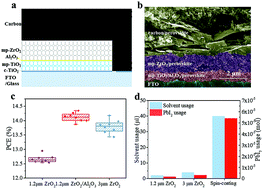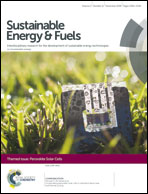Improvements in printable mesoscopic perovskite solar cells via thinner spacer layers†
Abstract
Printable mesoscopic perovskite solar cells based on TiO2/ZrO2/carbon mesoporous scaffolds have a promising future in commercialization due to their stability and ease of large-scale manufacturing, in which the mesoporous ZrO2 (mp-ZrO2) spacer is crucial in decreasing charge carrier recombination. To obtain high-performance devices, 2–3 μm thick mp-ZrO2 is usually needed. However, such thickness leads to an increased loading amount of perovskite material and causes problems such as reproducibility, pollution, and waste. Herein, we provide a universal solution to enhance VOC in printable mesoscopic PSCs with thin mp-ZrO2 layers. By depositing a thin layer of Al2O3 using a spraying pyrolysis method, we successfully retard the recombination between the TiO2 and carbon electrode. We further find the modification could down-shift the conduction band minimum (CBM) and increase the carrier transportation. Finally, we successfully reduce the mp-ZrO2 thickness of devices from 3 μm to 1.2 μm while retaining comparable device performance. Thanks to thinner ZrO2 layers, the usage of solvent and PbI2 is also reduced, which makes the device both more cost-efficient and environmentally friendly. This modification strategy will pave the way to the commercialization of printable mesoscopic PSCs with greener and cheaper processes.

- This article is part of the themed collection: Perovskite solar cells


 Please wait while we load your content...
Please wait while we load your content...